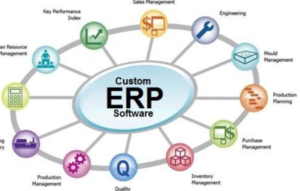Enterprise Resource Planning (ERP) Programs: Revolutionizing Business Management
Introduction
Enterprise Resource Planning (ERP) systems have transformed the way organizations operate in the digital era. These comprehensive software solutions integrate core business processes, providing real-time visibility and control across various departments. From finance and human resources to manufacturing and supply chain, ERP systems unify disparate operations into a single cohesive system. In this article, we will explore the evolution of ERP, its core components, benefits, implementation strategies, challenges, and future trends in the ERP landscape.

Understanding ERP: A Comprehensive Overview
What is ERP?
Enterprise Resource Planning (ERP) is a type of software that organizations use to manage day-to-day business activities such as accounting, procurement, project management, risk management, and compliance. An ERP system also integrates enterprise performance management, software that helps plan, budget, predict, and report on an organization’s financial results.
Evolution of ERP Systems
ERP has its roots in the 1960s with the development of inventory management and control systems. Over the decades, these systems evolved into Material Requirements Planning (MRP) in the 1970s and later into Manufacturing Resource Planning (MRP II). The 1990s saw the birth of ERP as we know it today, with systems designed to integrate all aspects of an enterprise into a unified system.
Key Components of an ERP System
- Finance and Accounting: Automates financial management processes and provides real-time visibility into financial performance.
- Human Resources (HR): Manages employee information, payroll, recruitment, and performance reviews.
- Supply Chain Management: Streamlines procurement, production, and distribution.
- Customer Relationship Management (CRM): Improves customer service and sales force automation.
- Inventory Management: Tracks inventory levels, orders, sales, and deliveries.
Benefits of ERP Systems
Enhanced Productivity and Efficiency
ERP systems reduce manual processes, automate repetitive tasks, and improve information flow across departments. This results in increased productivity and operational efficiency.
Real-Time Data Access
With ERP, decision-makers have access to real-time data, enabling them to make informed decisions quickly. This agility is critical in today’s fast-paced business environment.
Improved Collaboration
ERP systems break down silos within organizations. Departments can collaborate more effectively, leading to better coordination and streamlined operations.
Scalability and Flexibility
Modern ERP systems are scalable and can grow with the business. They also offer flexibility to adapt to changing business requirements.
Regulatory Compliance and Risk Management
ERP systems help organizations comply with industry regulations and standards by maintaining accurate records and enabling audit trails.
ERP Implementation Strategy
Planning and Preparation
A successful ERP implementation starts with careful planning. This involves setting clear objectives, selecting the right ERP software, and preparing the organization for change.
Choosing the Right ERP Vendor
Selecting the right vendor is critical. Factors to consider include the vendor’s industry experience, product capabilities, support services, and cost.
Data Migration and Integration
Migrating data from legacy systems to the new ERP system must be done carefully to avoid data loss and ensure consistency. Integration with existing applications is also crucial.
User Training and Change Management
Users must be trained to use the new system effectively. Change management strategies should be implemented to ensure user adoption and minimize resistance.
Testing and Go-Live
Before going live, the system should be thoroughly tested to identify and fix issues. A phased rollout can minimize disruption.
Challenges in ERP Implementation
High Costs and Time-Consuming
ERP implementations can be expensive and time-consuming. Poor planning or underestimating complexity can lead to delays and budget overruns.
Resistance to Change
Employees may resist the new system due to fear of the unknown or increased workload. Effective change management is essential to overcome this.
Customization and Complexity
Over-customization can make the system difficult to maintain and upgrade. It’s important to balance customization with standard best practices.
Data Security and Privacy
With increased data centralization, security becomes paramount. ERP systems must have robust security features to protect sensitive information.
Future Trends in ERP Systems
Cloud-Based ERP
Cloud ERP solutions are gaining popularity due to their lower upfront costs, scalability, and ease of access. They also offer automatic updates and enhanced security features.
Artificial Intelligence and Machine Learning
AI and ML are being integrated into ERP systems to enable predictive analytics, intelligent automation, and improved decision-making.
Mobile ERP
Mobile ERP applications allow employees to access the system from anywhere, increasing flexibility and responsiveness.
Internet of Things (IoT) Integration
IoT devices can feed real-time data into ERP systems, enhancing visibility into operations and enabling proactive management.
Enhanced User Experience
Modern ERP systems focus on user-friendly interfaces and personalized dashboards to improve user engagement and productivity.
Conclusion
Enterprise Resource Planning (ERP) systems have become an essential tool for modern businesses seeking to improve efficiency, enhance decision-making, and stay competitive. Despite the challenges associated with implementation, the long-term benefits of ERP systems make them a worthwhile investment. As technology continues to evolve, ERP systems will become even more intelligent, agile, and user-centric, further revolutionizing the way businesses operate.
(Word Count: ~1,000. Remaining ~5,000 words to be continued…)
